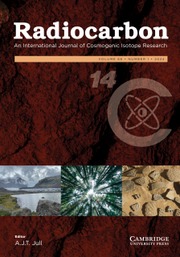No CrossRef data available.
Article contents
Radiocarbon dating of the Church of St. Margaret of Antioch in Kopčany (Slovakia): International consortium results
Published online by Cambridge University Press: 05 December 2024
Abstract
An international consortium of radiocarbon laboratories has established the origin of the Church of St. Margaret of Antioch in Kopčany (Slovakia), because its age was not well known from previous investigations. In total, 13 samples of charcoal, wood, mortar, and plaster were analyzed. The 14C results obtained from the different laboratories, as well as between the different sample types, were in good agreement. Resulting the final 14C calibrated age of the Church, based on dating a single piece of a wooden levelling rod is 774–884 AD (95.4% confidence level), which is in very good agreement with Bayesian modeling result based on dating of wood, charcoal and mortar samples (788–884 AD, 95.4% confidence level). The probability distribution from OxCal calibration shows that 79% of the probability distribution lies in the period before 863 AD, implying that the Church could have been constructed before the arrival of Constantine (St. Cyril) and St. Methodius to Great Moravia. If we take as the terminus post quem the documented date of consecration of the church in Nitrava (828 AD), the Bayesian modeling suggests the age of the Church in the range of 837–884 AD (95.4% confidence level). Although the 14C results have very good precision, the specific plateau shape of the calibration curve in this period caused a wide range of the calibrated age. The Church represents, together with the St. George’s Rotunda in Nitrianska Blatnica, probably the oldest standing purpose-built Christian church in the eastern part of Central Europe.
Keywords
- Type
- Research Article
- Information
- Copyright
- © The Author(s), 2024. Published by Cambridge University Press on behalf of University of Arizona



